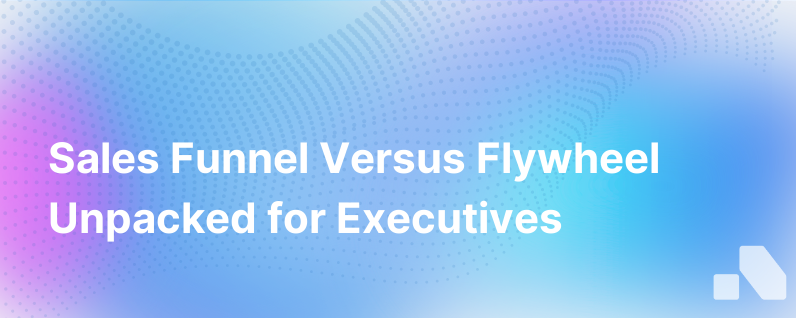Sales Funnel Vs Flywheel
Published on October 17, 2023 by Sawyer Middeleer
In today's ever-evolving business landscape, understanding customer acquisition and retention strategies is crucial for success. The sales funnel and the flywheel are two models businesses use to conceptualize the customer journey, each with unique philosophies and implications for strategy. For businesses deciding which approach is more aligned with their growth agendas, a deeper dive into the dynamics, advantages, and limitations of each model is essential. Let's dissect these concepts and analyze how they fit into modern business practices.
Understanding the Sales Funnel
The sales funnel represents the traditional model of customer acquisition, visualizing the customer's journey as a linear progression through stages: Awareness, Interest, Decision, and Action. Picture a funnel – wide at the top and narrow at the bottom; prospects enter at the top and the qualified, converted customers emerge from the bottom.
Stages of the Sales Funnel
- Awareness: Potential customers become aware of your products or services through various marketing channels.
- Interest: Prospects express interest by engaging with your content, signing up for newsletters, or following your social media.
- Decision: The critical stage where prospects evaluate your offering against competitors and prepare to make a purchase decision.
- Action: The bottom of the funnel, where the decision translates into a purchase.
The sales funnel has been the dominant model due to its simplicity, linear approach to tracking conversions, and clear division of marketing and sales areas of accountability.
The Limitations of the Sales Funnel
Despite its widespread adoption, the sales funnel has its drawbacks. It's often criticized for its one-directional nature, treating customer journeys as a one-time transaction rather than a cycle. Put simply, it has an "end" at the point of purchase, suggesting no further action or engagement is required, inadvertently neglecting post-sale customer interactions such as retention, cross-selling, upselling, and referrals.
The Emergence of the Flywheel
The flywheel model pivots from the funnel's linear transactional approach to a more holistic, customer-centric view. Rather than ending with a purchase, the flywheel emphasizes the momentum of ongoing customer engagement, satisfaction, and retention.
Picture a circular, rotating wheel: The flywheel uses the metaphor of kinetic energy to illustrate how businesses can leverage their existing customers to drive referrals and repeat sales, thus keeping the momentum of growth steady.
Components of the Flywheel
- Attract: Drawing in potential customers through content marketing, SEO, social media, and other channels.
- Engage: Interacting with prospects, understanding their needs, and moving toward providing a solution.
- Delight: Going beyond the purchase to ensure customer satisfaction, foster loyalty, and encourage advocacy.
The force at each stage of the flywheel is driven by the quality of customer experience. Positive experiences apply force that accelerates the wheel's spin, while negative experiences apply friction that decelerates it.
Advantages of the Flywheel
The major advantage of the flywheel is that it fosters a company culture focused on nurturing customer relationships at every stage – even after the sale. It's about creating brand advocates who will fuel growth through word-of-mouth and loyalty. Moreover, it reflects the interconnected reality of modern customer journeys, which are seldom linear and often subject to influence at various points after the initial sale.
Sales Funnel Vs. Flywheel: The Comparative Analysis
When we put the sales funnel next to the flywheel, contrasts become evident:
- Direction: The Funnel is linear, ending with the sale, whereas the Flywheel is cyclical, keeping the customer at the core of continuous motion.
- Focus: The Funnel is transaction-focused – it's about the singular purchase – while the Flywheel is relationship-focused, emphasizing organic growth through customer satisfaction and advocacy.
- Efficiency: The Funnel tends to lose momentum with each sale as efforts reset to generate new leads; the Flywheel, conversely, stores and increases energy as happy customers attract new ones.
- Resilience: The Funnel can be brittle — a drop at any stage impacts the final output significantly. The Flywheel, however, is robust, often self-sustaining through the loyalty and evangelism of satisfied customers.
The flywheel highlights the transformative power of customer retention. Businesses with high customer retention rates understand that the flywheel model emphasizes the value of their existing customer base as a springboard for growth. Moreover, in SaaS and subscription-based models, where lifetime value is critical, the flywheel portrays the dynamics of customer relationships more accurately than the funnel.
Choosing the Right Model for Your Business
While the flywheel represents a modern, customer-centric approach to growth and is aligned with today's interconnected, digital-first marketplace, it doesn't mean the sales funnel is obsolete.
In fact, the two can coexist effectively. The sales funnel can still be applied to understand and optimize conversions at specific stages of customer acquisition while using the flywheel to frame the broader customer lifecycle and post-purchase engagements. Combining the strengths of both models could present the most pragmatic approach — using the funnel's clarity of stages and the flywheel's emphasis on momentum.
Conclusion
As your business plans its growth strategy, consider the merits of both the sales funnel and the flywheel. Traditional sales models have their place in structured tracking and conversions, but the flywheel's dynamic nature ties in customer satisfaction and advocacy into your core business strategy. Embrace the idea that every satisfied customer can be the force that keeps your growth spinning, and build a business model that reflects this power.
The sales funnel’s legacy in understanding customer acquisition remains useful, but as business models evolve and customer expectations shift towards demand for continuous value and engagement, the flywheel offers a compelling paradigm that captures the essence of sustainable growth in the digital age.